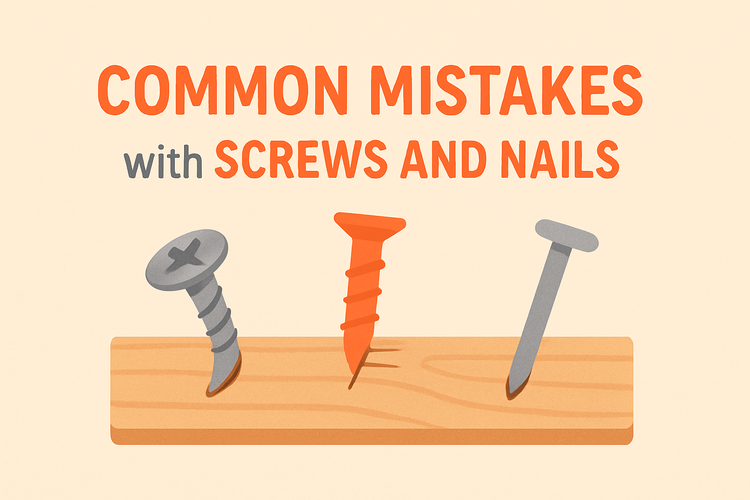Common Mistakes With Screws And Nails For Timber Projects

Using the Wrong Type of Fastener
Choosing the wrong screw or nail for a timber project is a common oversight. Not all fasteners are suitable for all types of wood or environmental conditions.
For example, exterior timber installations require corrosion-resistant fasteners like stainless steel or galvanized screws. Using standard interior nails in outdoor settings can lead to rust, which compromises both aesthetics and structural integrity. Similarly, structural timber projects should employ fasteners designed to carry heavy loads. Fasteners under the Screws and nails category include treated options for both indoor and outdoor applications, ensuring a better fit for your specific needs.
If you're working with engineered wood such as cross laminated timber or Glulam, it's essential to use specialized fasteners and connectors. Standard nails might not provide the holding power required by denser engineered wood. For such applications, explore options in Connectors for cross laminated timber or Connectors for Glulam Timber collections to ensure compatibility and durability.
Overdriving or Underdriving Fasteners
It's not just about the fastener you use, but how you use it. Overdriving and underdriving screws and nails can cause significant performance issues in timber construction.
Overdriving screws may split the timber, especially softwoods, reducing their load-bearing capacity and weakening the overall structure. It also countersinks the fastener too deeply, which can affect connections and damage finishes. Underdriving, on the other hand, prevents proper engagement of hardware and can leave fasteners protruding, posing both a safety hazard and an unattractive appearance.
For optimal results, use torque-controlled screwdrivers or adjustable drill settings to maintain consistent driving depth. Fastener designs available in the Screws and nails range often include self-countersinking heads which help mitigate the risk of poor installation. Matching your tools to your fasteners goes a long way in improving both performance and appearance.
Inadequate Fastener Length and Size
One of the most frequent mistakes in timber projects is selecting fasteners that are too short or too long. Fastener length impacts holding strength and overall safety.
Short screws or nails may not penetrate deeply enough into the timber, resulting in weak joints that can pull apart under load. Using fasteners that are too long, conversely, increases the risk of them protruding through the reverse side of the timber, posing both an aesthetic concern and a potential injury hazard. The rule of thumb is that fasteners should penetrate the secondary piece of timber by at least half its thickness without emerging out the other side.
Moreover, diameter matters. Thinner nails or screws may bend during installation or shear off under stress, while overly thick fasteners can split the wood. Choose fasteners matched to the type of timber and the purpose of the project. For structural applications like beams or decking, always refer to the fastener guidelines provided with load-rated products. Moreover, when combining fasteners with hardware like Post Base supports or Angle Brackets, ensure the length and gauge comply with the connector’s specifications for maximum load transfer.
Incorrect Spacing and Fastener Placement
Spacing fasteners too closely or too far apart can lead to problems in joint performance and timber health. Placement plays a crucial role in overall build quality.
Overcrowding fasteners can cause wood to split, especially at the ends of boards. It's important to maintain recommended edge and end distances, typically about 20–30 mm from the end and at least 10 mm from the edge depending on the timber and fastener size. Conversely, placing fasteners too far apart may reduce joint strength or allow movement and deformation.
Use of fasteners in conjunction with structural components like Joist Hangers or Timber Frame Connectors can help ensure consistent placement and load distribution. These accessories often come with pre-drilled holes and guidelines to simplify and standardize fastener use. Consulting the manufacturer’s spacing specifications helps avoid common layout mistakes and results in more reliable timber structures.
Mixing Nails and Screws Improperly
Screws and nails serve different purposes and are not always interchangeable despite being used in similar applications. Knowing when to use which is critical.
Nails are more flexible and can handle shear force better, which is why they are often used in framing and structural components where lateral movement may occur. Screws, however, have superior holding power and are often chosen for cabinetry, decking, and applications requiring disassembly or added clamping force. A common mistake is using nails in situations requiring tension resistance, or vice versa, leading to premature failure or inefficient fastening.
It's also not advisable to mix nails and screws within the same joint. The different mechanical properties can lead to uneven stress distribution and wood movement over time. When using certified building products like Restraint Straps or Roof Connectors, ensure you use the fastener type and configuration specified by the manufacturer. Doing so helps maintain compliance and structural effectiveness across your timber construction project.
